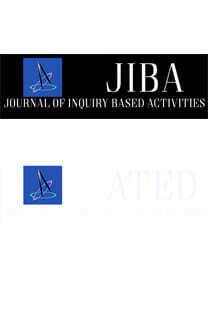MATHEMATICAL MODELING ACTIVITY: MURAT’S MOBILE PHONE
In this study, a mathematical modeling activity was designed and implemented in a seventh grade classroom. The students were first expected to examine a given mathematical model of a problem that is based on a real life situation and then build a model depending on their own criteria. The mathematical modeling activity which was designed by the researchers involves many mathematical concepts and processes such as analyzing data, reading a table, interpreting a table, building a model, drawing a graph, and interpreting a graph. After application of the modeling activity, students were evaluated based on their performance in solving the mathematical modeling questions and almost all were found to be successful. The researchers offered some recommendations through their experiences for teachers. Among these recommendations are that every student should present their mathematical model to class and discuss it with other students
BİR MATEMATİKSEL MODELLEME ETKİNLİĞİ: MURAT’IN CEP TELEFONU
Bu araştırmanın amacı yedinci sınıf öğrencilerine yönelik hazırlanmış bir matematiksel modelleme etkinliğini uygulama sürecinde öğrencilerin deneyimlerini incelemektir. Bir gerçek yaşam durumunun matematiksel olarak incelendiği problemde, öğrencilerden kendilerine verilen bir matematiksel modeli incelemeleri ve kendi belirledikleri ölçütlerle yeni bir matematiksel model oluşturmaları beklenmiştir. Araştırmacılar tarafından hazırlanan bu matematiksel modelleme etkinliği verileri inceleme, tablo okuma, tabloyu yeniden yorumlama, bir model oluşturma ve grafik çizme-yorumlama gibi birçok matematiksel kavramı ve süreci barındırmaktadır. Uygulanan etkinlik sonucunda öğrencilerin bu matematiksel modelleme sorusunu çözme süreçleri değerlendirilmiş ve hemen hemen tüm sınıf, etkinlik sürecinde başarılı olarak değerlendirilmiştir. Uygulamanın sonunda araştırmacılar, öğretmenlere süreçten elde ettikleri gözlem deneyimlerine dayanarak bazı öneriler sunmuştur. Bunlar arasında tahtada her bir öğrencinin ürettiği matematiksel modelin incelenmesi ve sınıf olarak yorumlar getirilmesi de yer almaktadır.
___
Bliss, K. M., Fowler, K. R., & Galluzzo, B. J. (2014). Math modeling: Getting started and getting solutions. Philadelphia, PA: SIAM. Retrieved from http://m3challenge.siam.org/resources/modeling-handbookBurrill, G., & Biehler, R. (2011). Fundamental statistical ideas in the school curriculum and in training teachers. In C. Batanero, G. Burrill, & C. Reading (Eds.), Teaching statistics in school mathematics-challenges for teaching and teacher education: A joint ICMI/IASE study (pp. 57-69). Netherlands: Springer Science Business Media. doi: 10.1007/978-94-007-1131-0_10
Deniz, D., & Akgün, L. (2014). Ortaöğretim öğrencilerinin matematiksel modelleme yönteminin sınıf içi uygulamalnmarına yönelik görüşleri [Secondary school students’ views on the classroom practices of mathematical modelling method]. Trakya Üniversitesi Eğitim Fakültesi Dergisi, 4(1), 103-116.
Doruk, B. K., & Umay, A. (2011). Matematiği günlük yaşama transfer etmede matematiksel modellemenin etkisi [The effect of mathematical modeling on transferring mathematics into daily life]. Hacettepe Üniversitesi Eğitim Fakültesi Dergisi, 41, 124-135.
Dossey, J. A., McCrone, S., Giordano, F. R., & Weir, M. D. (2002). Mathematics methods and modeling for today’s mathematics classroom: A contemporary approach to teaching grade 7-12. Pacific Grove, California: Brooks/Cole.
Franklin, C., Kader, G., Mewborn, D. S., Moreno, J., Peck, R., Perry, M., & Scheaffer, R. (2005). Guidelines for assessment and instruction in statistics education (GAISE) report: A pre-K-12 curriculum framework. Alexandria, VA: American Statistical Association
Lesh, R. A., & Zawojewski, J. S. (2007). Problem solving and modeling. In F. Lester (Ed.), Second handbook of research on mathematics teaching and learning (pp. 763-804). Greenwich, CT: Information Age Publishing.
Ministry of National Education. (2013). Ortaöğretim matematik dersi (9, 10, 11 ve 12. sınıflar) öğretim program [Secondary education mathematics (9, 10, 11 and 12. grades) curriculum]. Ankara: Talim ve Terbiye Kurulu Başkanlığı.
Ministry of National Education. (2018). Matematik dersi öğretim programı (İlkokul ve ortaokul 1, 2, 3, 4, 5, 6, 7 ve 8. sınıflar) [Mathematics curriculum (Elementary and middle school 1, 2, 3, 4, 5, 6, 7 and 8. grades)]. Retrived from http://mufredat.meb.gov.tr/ProgramDetay.aspx?PID=329.
Mousoulides, N., & English, L. D. (2008). Modeling with data in Cypriot and Australian classrooms. In O. Figueras, J. L. Cortina, S. Alatorre, T. Rojano, & A. Sepulveda (Eds.), Proceedings of the 32nd International Conference of the International Group for the Psychology of Mathematics Education (Vol 3, pp. 423-430). Morelia, Mexico: University of Morelia.
National Council of Teachers of Mathematics. (2000). Principles and standards for school mathematics. Reston, VA: Author.
National Governors Association Center for Best Practices, Council of Chief State School Officers (2010). Common core state standards for mathematics. Retrieved from http://www.corestandards.org/Math/Practice/
New Zealand Ministry of Education. (2014). Mathematics and statistics. Retrieved from http://nzcurriculum.tki.org.nz/The-New-Zealand-Curriculum/Mathematics-and-statistics
Van de Walle, J. A., Karp, K. S., & Bay-Williams, J. M. (2013). İlkokul ve ortaokul matematiği: Gelişimsel yaklaşımla öğretim [Elementary and middle school mathematics: Teaching developmentally] (S. Durmuş, Trans. Ed.). Ankara: Nobel Akademik Yayıncılık.
- ISSN: 2146-5711
- Yayın Aralığı: Yılda 2 Sayı
- Başlangıç: 2011
- Yayıncı: Evrim Erbilgin
Sayıdaki Diğer Makaleler
YARATICI DRAMA İLE MATEMATİK ÖĞRENİYORUM
PREPARING DATA REPRESENTATION ACTIVITIES FOR YOUNG LEARNERS
RUS KÖYLÜLERİN GELİŞTİRDİĞİ ÇARPMA YÖNTEMİ NASIL VE NEDEN ÇALIŞIYOR?
HOW AND WHY DOES THE MULTIPLICATION METHOD DEVELOPED BY THE RUSSIAN PEASANTS WORK?
LEARNING MATHEMATICS WITH CREATIVE DRAMA
KÜÇÜK ÇOCUKLAR İÇİN VERİ GÖSTERİMİNE YÖNELİK AKTİVİTELER HAZIRLAMA
BİR MATEMATİKSEL MODELLEME ETKİNLİĞİ: MURAT’IN CEP TELEFONU
Burçak BOZ-YAMAN, Melike UYARLI
MATHEMATICAL MODELING ACTIVITY: MURAT’S MOBILE PHONE
